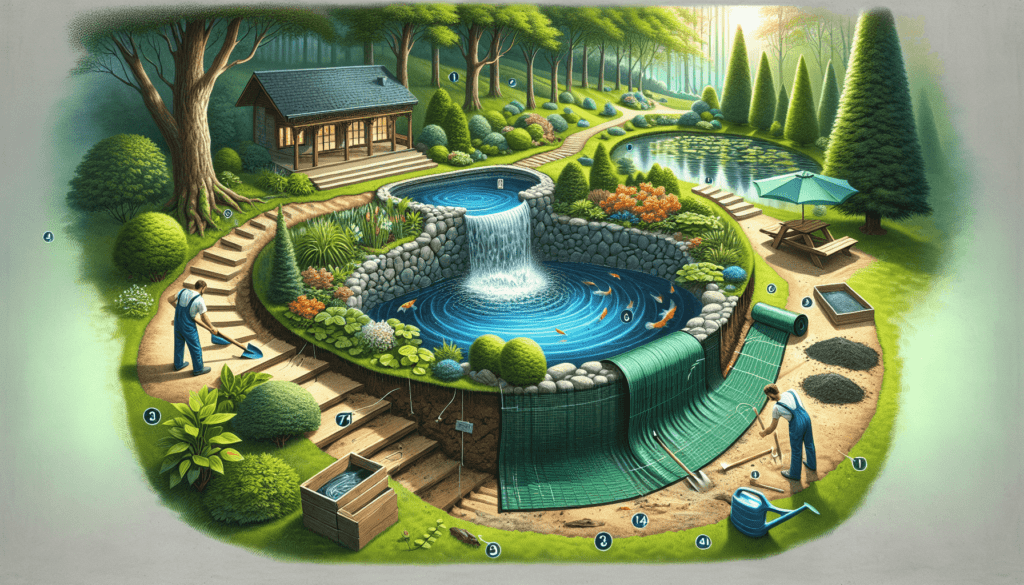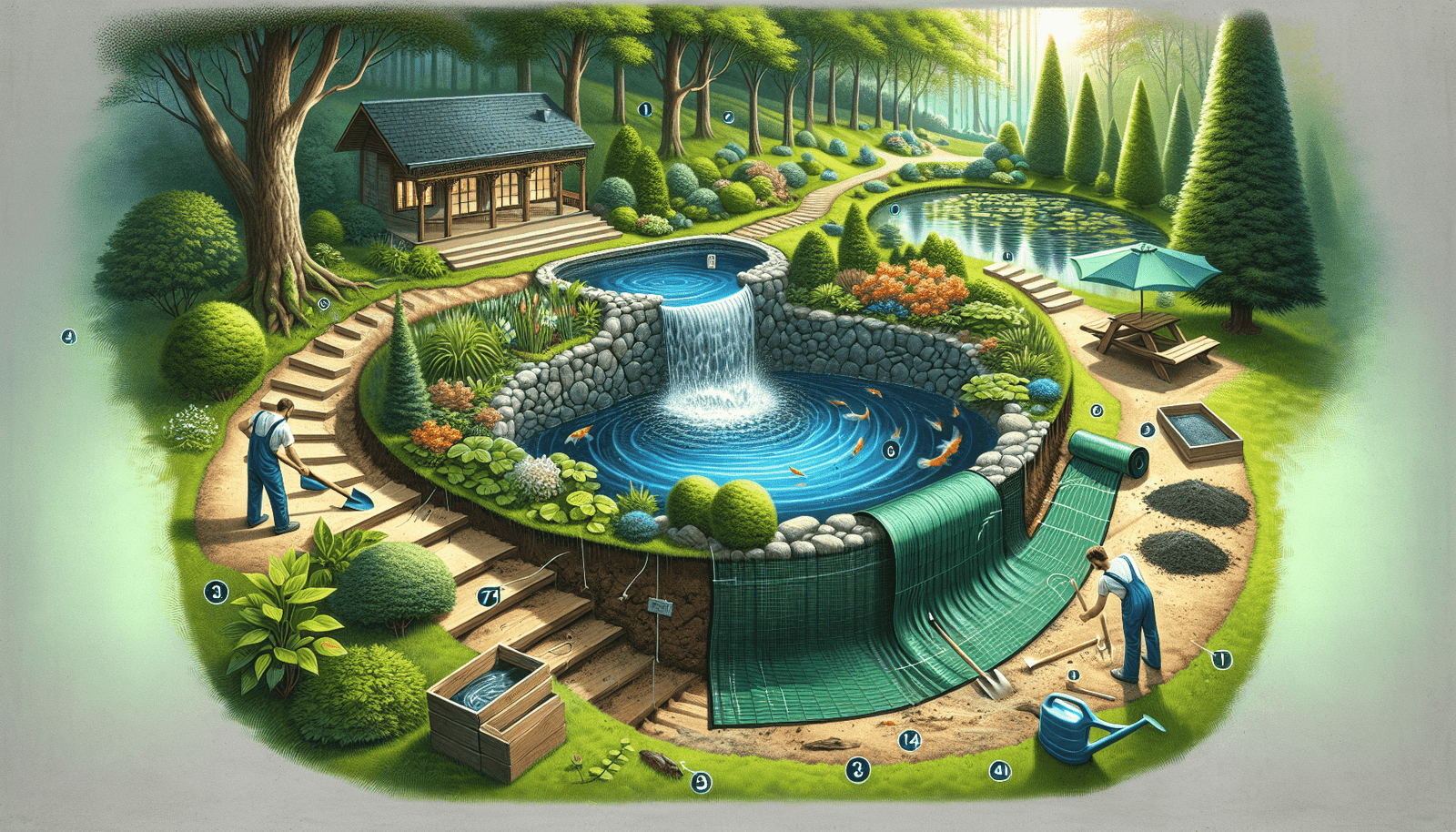Welcome to “The Essentials of Building a Garden Pond,” where we will explore the key elements needed to create your very own tranquil oasis right in your backyard. From selecting the right location and size for your pond to choosing the proper materials and aquatic plants, this guide will provide you with all the information you need to get started on your gardening adventure. So grab your shovel and let’s dive into the world of building a beautiful garden pond that you can enjoy for years to come.

Have you been thinking about adding a garden pond to your backyard but don’t know where to start?
Creating a garden pond can bring a sense of tranquility and beauty to your outdoor space. Whether you want to attract wildlife, create a relaxing oasis, or simply enhance the aesthetics of your garden, building a garden pond can be a rewarding project. In this article, we will guide you through the essentials of building a garden pond, so you can bring your vision to life.
Planning the Location of Your Garden Pond
The first step in building a garden pond is to carefully consider its location. Choose a spot that receives a good amount of sunlight but is not in direct sunlight all day. This will help maintain the water temperature and promote the growth of aquatic plants. It’s also important to avoid placing the pond near trees or bushes, as falling leaves and debris can clog the pond and make maintenance more difficult.
When planning the location of your garden pond, also take into account the proximity to power sources for pumps and filters, as well as access to water for filling and topping up the pond. Consider the surrounding landscape and how the pond will fit into the existing layout of your garden.
Choosing the Size and Shape of Your Garden Pond
The size and shape of your garden pond will depend on various factors, including the available space in your garden, your budget, and the desired aesthetic. A smaller pond can still make a big impact in your garden, while a larger pond will provide more room for aquatic plants and fish.
When deciding on the shape of your garden pond, consider the overall design of your garden. A rectangular pond may complement a formal garden, while a kidney-shaped pond can enhance a more naturalistic landscape. Think about how the shape of the pond will interact with the surrounding plants and features to create a harmonious design.

Digging and Excavating the Pond
Once you have determined the location, size, and shape of your garden pond, it’s time to start digging. Use a rope or hose to outline the perimeter of the pond, then mark the shape with spray paint or stakes. Start digging from the center of the pond and work your way outwards, creating shelves at different depths for aquatic plants and wildlife to thrive.
When excavating the pond, remember to create varying depths to accommodate different types of aquatic life. A deeper section will provide a refuge for fish during hot weather, while shallower areas will support the growth of aquatic plants. Plan for a gradual slope along the edges of the pond to allow for easy access for wildlife and maintenance.
Installing a Pond Liner
Once you have excavated the pond to the desired depth and shape, it’s time to install a pond liner. A pond liner is essential for preventing water leakage and maintaining the integrity of the pond. Choose a durable liner made of PVC, rubber, or EPDM that is resistant to UV rays and punctures.
Before installing the pond liner, make sure the bottom of the pond is smooth and free of sharp objects that could puncture the liner. Lay the liner over the excavated pond, allowing excess material to drape over the edges. Gently press the liner into place, smoothing out any wrinkles or folds to ensure a tight fit.
Adding a Filtration System
To keep your garden pond clean and healthy, it’s essential to install a filtration system. A filtration system helps remove debris, sediment, and organic matter from the water, preventing algae growth and maintaining water clarity. There are several types of filters available, including biological filters, mechanical filters, and UV clarifiers.
Biological filters use beneficial bacteria to break down organic waste and harmful substances, while mechanical filters trap debris and particles suspended in the water. UV clarifiers use ultraviolet light to kill algae and sterilize the water, reducing the risk of disease. Choose a filtration system that suits the size and depth of your pond, as well as the type of aquatic life you plan to keep.
Adding Water and Plants to Your Garden Pond
After installing the filtration system, it’s time to fill your garden pond with water. Use dechlorinated water to avoid harming aquatic plants and fish, and consider using a water conditioner to remove chlorine, chloramine, and heavy metals. Fill the pond slowly to allow the water to settle and prevent stirring up sediment.
Once the pond is filled with water, it’s time to add aquatic plants to enhance its beauty and provide habitat for wildlife. Choose a variety of plants, including submerged, floating, and marginal plants, to create a balanced ecosystem. Submerged plants help oxygenate the water and provide shelter for fish, while floating plants control algae growth and provide shade. Marginal plants soften the edges of the pond and attract beneficial insects.
Introducing Fish and Wildlife to Your Garden Pond
If you plan to keep fish in your garden pond, choose species that are suitable for the size and depth of the pond, as well as the climate in your area. Common pond fish include goldfish, koi, and mosquito fish, which thrive in a variety of water conditions and feed on algae and insects. Introduce fish gradually to allow them to acclimate to their new environment.
To attract wildlife to your garden pond, consider adding features like rocks, logs, and platforms for birds, frogs, and insects to perch on and shelter in. Create a diversity of habitats, including shallow areas for birds to bathe and drink, and deeper areas for fish to swim and hide. Provide food sources like native plants, insects, and algae to support a thriving ecosystem.
Maintaining and Caring for Your Garden Pond
Once your garden pond is up and running, it’s important to establish a regular maintenance routine to keep it clean and healthy. Test the water quality regularly using a water testing kit to monitor pH levels, ammonia, nitrites, and nitrates. Adjust the water chemistry as needed to maintain a stable and balanced environment for aquatic life.
Remove debris like fallen leaves, twigs, and algae from the surface of the pond using a skimmer or net. Trim and prune aquatic plants to prevent overcrowding and maintain optimal oxygen levels. Clean the filter regularly to ensure it is functioning properly and remove any buildup of organic matter.
Enjoying the Benefits of Your Garden Pond
Creating a garden pond is a fulfilling and rewarding project that can transform your outdoor space into a tranquil and vibrant oasis. By carefully planning the location, size, and shape of the pond, selecting the right plants and fish, and maintaining the ecosystem, you can enjoy the beauty and serenity of your garden pond for years to come.
Take the time to observe the wildlife that visits your pond, from colorful fish and graceful birds to busy insects and croaking frogs. Sit by the pond and listen to the soothing sound of water flowing over rocks, or watch the sunlight dance on the surface of the water. Your garden pond is a place of beauty and relaxation, a living work of art that enriches your life and brings joy to all who visit.

